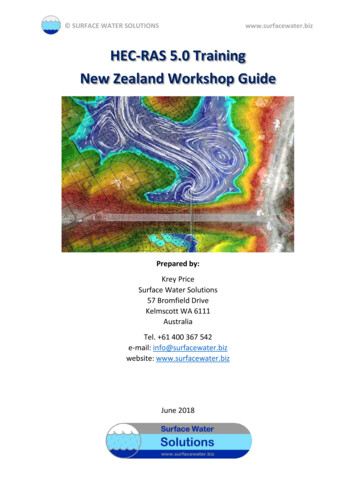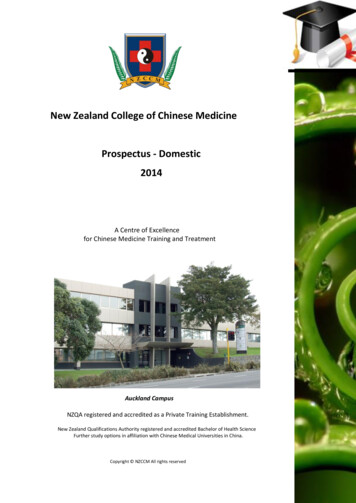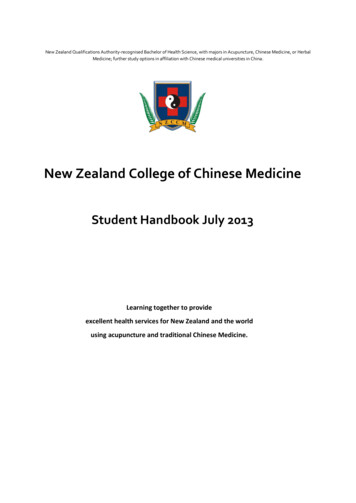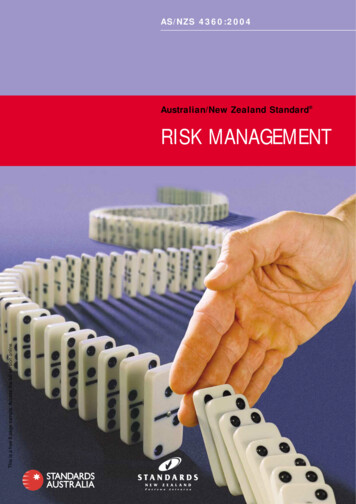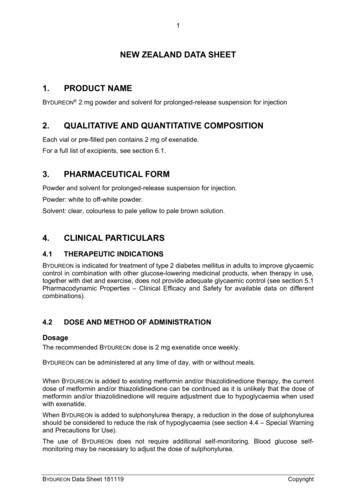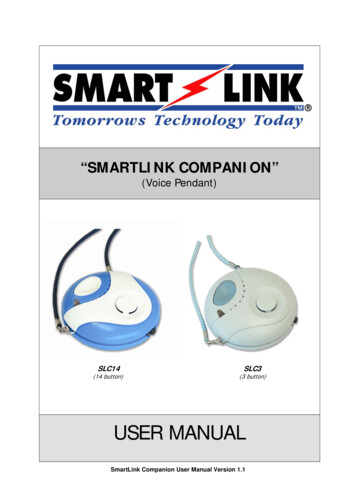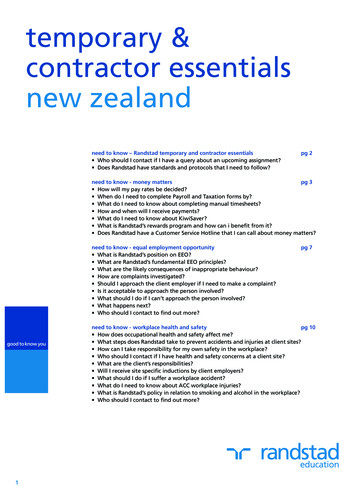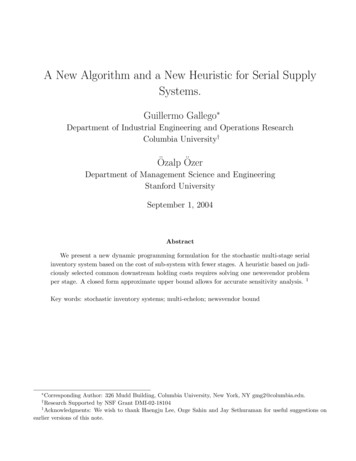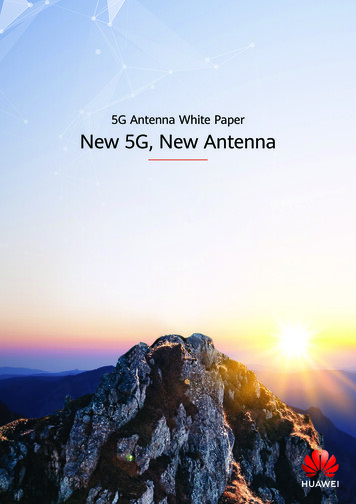Transcription
NEW ZEALAND’SSYSTEM OFBUOYS ANDBEACONS
Disclaimer: All care and diligence has been used in extracting, analysing andcompiling this information, however, Maritime New Zealand gives no warranty thatthe information provided is without error.Copyright Maritime New Zealand 2008Parts of this publication may be reproduced provided acknowledgement is madeto this publication and Maritime New Zealand as the source.ISBN 0-478-18815-3
CONTENTS3Introduction4System of Buoyage and Beaconage5Description of System6Rules for Marks7Lateral Marks9Cardinal Marks12Isolated Danger Marks13Safe Water Marks14Special Marks15New Dangers16Miscellaneous17Offshore Oil/Gas Rigs and Platforms18Marine Farms18Reflective Strips19Oceanographic Stations20Standard Submarine Cable/Pipeline Marker Beacon21Bridges and Overhead Power Lines22Overhead Power Lines22Safe Clearance Signs23Safe Clearance Diagram24Light Characteristics1
INTRODUCTIONThis book explains the buoyage and beaconage systemin New Zealand waters. It describes the recommendedrequirements for aids to navigation in harbours and theirapproach channels, methods of marking and lighting, andalso describes the requirements for oceanographic stationsthat may be established around our seaboard. Details ofstandard markings for Marine Farms, Offshore IsolatedDangers, Oil Rigs and other miscellaneous markings arealso included.All members of the maritime community should find thisbook useful, particularly mariners, Regional Councils, PortCompanies, and those studying for nautical examinations.3
SYSTEM OFBUOYAGE AND BEACONAGEThe waters of New Zealand and adjacent islands are marked for safenavigation using the International Association of Marine Aids to Navigationand Lighthouse Authorities (IALA) System ‘A’ Maritime Buoyage System.This system uses Marks which have a variety of colours, shapes and lightcharacteristics arranged in simple ways to show the side on which a buoyor beacon should be passed when heading in a given direction, indicated onthe appropriate chart.In addition to this system, many unlighted buoys and beacons have reflectivemarking strips to aid visibility at night.Within the IALA Buoyage System there are five types of Marks which may beused in combination, and they can be told apart by their shapes.4The five basic shapes are:Can (cylindrical)ConicalSphericalPillarSparIn the case of can, conical and spherical buoys, their shape indicates thecorrect side to pass. Pillar and spar should still have Top Marks and colourin System A. The pillar and spar buoys’ shape does not indicate the side ofpassage although they should be the appropriate colour and have the correctshaped Top Mark. A pillar is a buoy that is smaller than a Lanby and hasa tall central structure on a broad base. Pillars include beacon buoys, highfocal plane buoys and others (except spar buoys) with body shapes that donot indicate the correct side to pass.A Lanby is a large navigation buoy which has a mast on top carrying a lightand other aids to navigation, at a height not less than 5 metres (16 feet)above the level of the water.
DESCRIPTION OF SYSTEMLateral MarksIn New Zealand, Lateral Marks use red and green colours at night andduring the day to define the port and starboard sides of channelsrespectively, when read in conjunction with the “Buoyage Direction”indicated on the appropriate chart.Modified Lateral Marks are sometimes used to show where a channeldivides, and to indicate the preferred channel or primary route.Cardinal MarksCardinal Marks indicate that the deepest water in the area lies to the namedside of the Mark. This convention is necessary even though, for example, aNorth Mark may have navigable water not only to the north but also east andwest of it. The mariner will be safe to the north, but must consult the relevantchart for further guidance.Isolated Danger MarkThe Isolated Danger Mark identifies a small area of danger which has navigablewater all around it.Safe Water MarksThe Safe Water Mark identifies an area which has navigable water all around itbut does not mark a danger. Safe Water Marks can by used, for example, asmid-channel or landfall Marks.Special MarksSpecial Marks are used to indicate a special area or feature, the nature ofwhich may be identified on a chart or in another nautical document.New DangersA “new danger” is one that is not yet shown in nautical documents. It may beindicated by exactly duplicating the normal Mark until the information is widelyknown. A New Danger Mark may carry a Racon coded Morse D “ — ”.5
RULES FOR MARKSNew Zealand’s system of buoyage and beaconage provides general ruleswhich apply to all fixed and floating Marks other than lighthouses, sectorlights, leading lights and marks, lightships and large navigational buoys.The system indicates:the lateral limits of navigational channels,natural dangers and other obstructions such as wrecks,other areas or features of importance to the mariner, ornew dangers.Types of MarksThe system of buoyage has five types of Marks that may be used in differentcombinations. They are:6LateralCardinalIsolated DangerSafe WaterSpecialHow to Identify What a Mark MeansThe meaning of a mark depends on its:By day:ColourShapeTop MarkBy night:ColourRhythm of light
LATERAL MARKSIdentifying the Conventional Direction of BuoyageThe conventional direction of buoyage, which is indicated on charts or inother appropriate nautical documents, is either:the general direction taken by the mariner when approaching aharbour, river, estuary or other waterway from seaward, orthe direction determined by Maritime New Zealand.Lateral MarksPORT HAND MARKSColour:RedShape (buoys):Cylindrical (can), pillar or sparTop Mark (if any):Single red cylinder (can)Light (when fitted)Colour:RedRhythm:Any, other than composite group flashingSTARBOARD HAND MARKSColour:GreenShape (buoys):Conical, pillar or sparTop Mark (if any):Single green cone, point upwardLight (when fitted)Colour:GreenRhythm:Any, other than composite group flashing7
Lateral Marks cont.At the point where a channel divides, when heading in the “conventionaldirection of buoyage”, the preferred channel may be indicated by a modifiedPort or Starboard Lateral Mark as follows:PREFERRED CHANNEL TO PORTColour:Green with one broad red horizontal bandShape (buoys):Conical, pillar or sparTop Mark (if any):Single green cone, point upwardLight (when fitted)Colour:GreenRhythm:Composite group flashing (2 1)PREFERRED CHANNEL TO STARBOARD8Colour:Red with one broad green horizontal bandShape (buoys):Cylindrical (can), pillar or sparTop Mark (if any):Single red cylinder (can)Light (when fitted)Colour:RedRhythm:Composite group flashing (2 1)General Rules for Lateral MarksShapesIf a Lateral Mark does not have a cylindrical (can) or conical buoy shape, itwill usually carry the appropriate Top Mark. Appropriate colours: red — Port,green — Starboard.Numbering or letteringIf Marks at the sides of a channel are numbered or lettered, the numberingor lettering follows the “conventional direction of buoyage”. The convention isPort even 2, 4, 6 etc. Starboard odd 1, 3, 5 etc.
CARDINAL MARKSCardinal Quadrants and MarksThe four quadrants (north, east, south and west) are bounded by the truebearings NW–NE, NE–SE, SE–SW, SW–NW, taken from the point of interest.A Cardinal Mark is named after the quadrant in which it is placed.Named Cardinals should be passed to the named side of the Mark (e.g. passnorth of a North Mark).Use of Cardinal MarksCardinal Marks:indicate that the deepest water in that area is on the named side ofthe mark; orindicate the safe side on which to pass a danger; ordraw attention to a feature in a channel such as a bend, a junction,where a channel divides or the end of a shoal.General Rules for Cardinal MarksCardinal Marks are normally pillar or spar. They are always painted in yellowand black horizontal bands and their distinctive double cone Top Marks arealways black.The direction of the Top Cone Marks identifies the type of Cardinal Mark (e.g.arrows up north , arrows oppositeeast). The yellow and black bandsdiffer for each mark, the Top Mark pointers act as guides (e.g. north conespoint up, band on top and east cones are opposite, band in the middle).Cardinal Marks also have a special system of flashing white lights. Therhythms are basically all “very quick” (VQ) or “quick” (Q) flashing, broken intovarying lengths of the flashing phase. “Very quick” flashing is when a lightflashes at a rate of either 120 or 100 flashes per minute; “quick” flashing iswhen a light flashes at either 60 or 50 flashes per minute.9
The characters used for Cardinal Marks are as follows:North: Continuous “very quick” or “quick” flashing.East:Three “very quick” or “quick” flashes followed by darkness.South: Six “very quick” or “quick” flashes followed immediately by a longflash, then darkness.West: Nine “very quick” or “quick” flashes followed by darkness.To help remember the character think of a clock face and the position ofthree, six and nine o’clock.West is nineEast is threeSouth is sixThe long flash, defined as a light appearance of not less than two secondsis merely a device to ensure that three or nine “very quick” or “quick” flashescannot be mistaken for six.Two other marks use white lights. Each has a distinctive light rhythm thatcannot be confused with the very quick or quick flashing light of the Cardinalmarks. These are the Isolated Danger Mark and the Safe Water Mark.NENWNVQ or QVQ(9) or Q(9)WVQ(3) or Q(3)NWPOINT OFINTERESTEESVQ6 L.Fl or Q6 L.FlSSESW10
NORTH CARDINAL MARKColour:Black above yellowShape (buoys):Pillar or sparTop Mark* (if any):2 black cones, one above the other, point upwardLight (when fitted)Colour:WhiteRhythm:Very quick (VQ) or quick (Q)EAST CARDINAL MARKColour:Black with a single broad horizontal yellow bandShape (buoys):Pillar or sparTop Mark* (if any):2 black cones, one above the other, base to baseLight (when fitted)Colour:WhiteRhythm:VQ(3) every 5s or Q(3) every 1Os11SOUTH CARDINAL MARKColour:Yellow above blackShape (buoys):Pillar or sparTop Mark* (if any):2 black cones, one above the other, points downwardLight (when fitted)Colour:WhiteRhythm:VQ(6) long flash every 10s or Q(6) long flash every 15sWEST CARDINAL MARKColour:Yellow with a single broad horizontal black bandShape (buoys):Pillar or sparTop Mark* (if any):2 black cones, one above the other, point to pointLight (when fitted)Colour:WhiteRhythm:VQ(9) every 10s or Q(9) every 15s* The double cone Top Mark is a very important feature of every Cardinal Mark by day, and should be usedwherever practicable and be as large as possible with a clear separation between the cones.
NOTIONAL DIRECTION USED IN NEW ZEALAND AS DETERMINED BYMARITIME NZ FOR THE MARITIME BUOYAGE SYSTEM AS USED IN REGION A12ISOLATED DANGER MARKSAn Isolated Danger Mark is erected or moored on or above an isolateddanger that has navigable water all around it. Distinctive double blackspherical Top Marks, a black base with red band and, when fitted, groupflashing (2) white lights, associate Isolated Danger Marks with Cardinal Marks.ISOLATED DANGER MARKSColour:Black with one or more broad horizontal red bandsShape (buoys):Optional, but not conflicting with Lateral Marks;pillar or spar preferredTop Mark* (if any):2 black spheres, one above the otherLight (when fitted)Colour:WhiteRhythm:Group flashing (2)* The double sphere Top Mark is a very important feature of every Isolated Danger Mark by day, and shouldbe used wherever practicable and be as large as possible with a clear space between the spheres.
SAFE WATER MARKSSafe Water Marks indicate that there is navigable water all round the Markand include centre line marks and mid-channel Marks. They may also beused as an alternative to Cardinal or Lateral Marks to indicate landfalls.Safe Water Marks look quite different from danger marking buoys. They arespherical, or may be a pillar or spar with a single red spherical Top Mark.They are the only type of Mark with vertical stripes (red and white).Their lights, if any, are white and use isophase, occulting, one long flashor Morse “A” rhythms.SAFE WATER MARKSColour:Red and white vertical stripesShape (buoys):Spherical, pillar or spar with spherical Top MarkTop Mark (if any):Single red sphereLight (when fitted)Colour:WhiteRhythm:Isophase, occulting, one long flash every 10sor Morse “ — ”.13
SPECIAL MARKSSpecial Marks indicate a special area or feature marked on a chart or referredto in appropriate nautical documents.Special Marks indicate:Ocean Data Acquisition Systems (ODAS) Markstraffic separation marks where use of conventional channel markingmay cause confusionspoil groundmilitary exercise zonescables or pipelinesrecreation zonesmarine farms14A Special Mark is yellow. It may carry a yellow “X” Top Mark, and if it hasa light, that will be yellow. Yellow lights on Special Marks should havecharacters other than those used for Cardinal, Isolated Danger and Safe Water.Their special shapes do not conflict with navigational Marks; this means, forexample, that a special buoy located on the Port hand side of a channel maybe cylindrical, but will not be conical. Special Marks may also be lettered ornumbered to indicate their purpose.SPECIAL MARKSColour:YellowShape (buoys):Optional, but not conflicting with navigational marksTop Mark (if any):Single yellow ‘X’ shapeLight (when fitted)Colour:YellowRhythm:Any, other than those used for Cardinal,Isolated Danger and Safe Water Marks
Additional Special MarksSpecial Marks, other than those already described, may be established byRegional Councils or other authorities in exceptional circumstances.These additional Marks should not conflict with navigational Marks, andwhen they are installed should be publicised in nautical documents, such asNotices to Mariners and on revised charts, and the International Associationof Marine Aids to Navigation and Lighthouse Authorities (IALA) should benotified as soo
Within the IALA Buoyage System there are five types of Marks which may be used in combination, and they can be told apart by their shapes. The five basic shapes are: Can (cylindrical) Conical Spherical Pillar Spar In the case of can, conical and spherical buoys, their shape indicates the correct side to pass. Pillar and spar should still have Top Marks and colour in System A. The pillar and .

